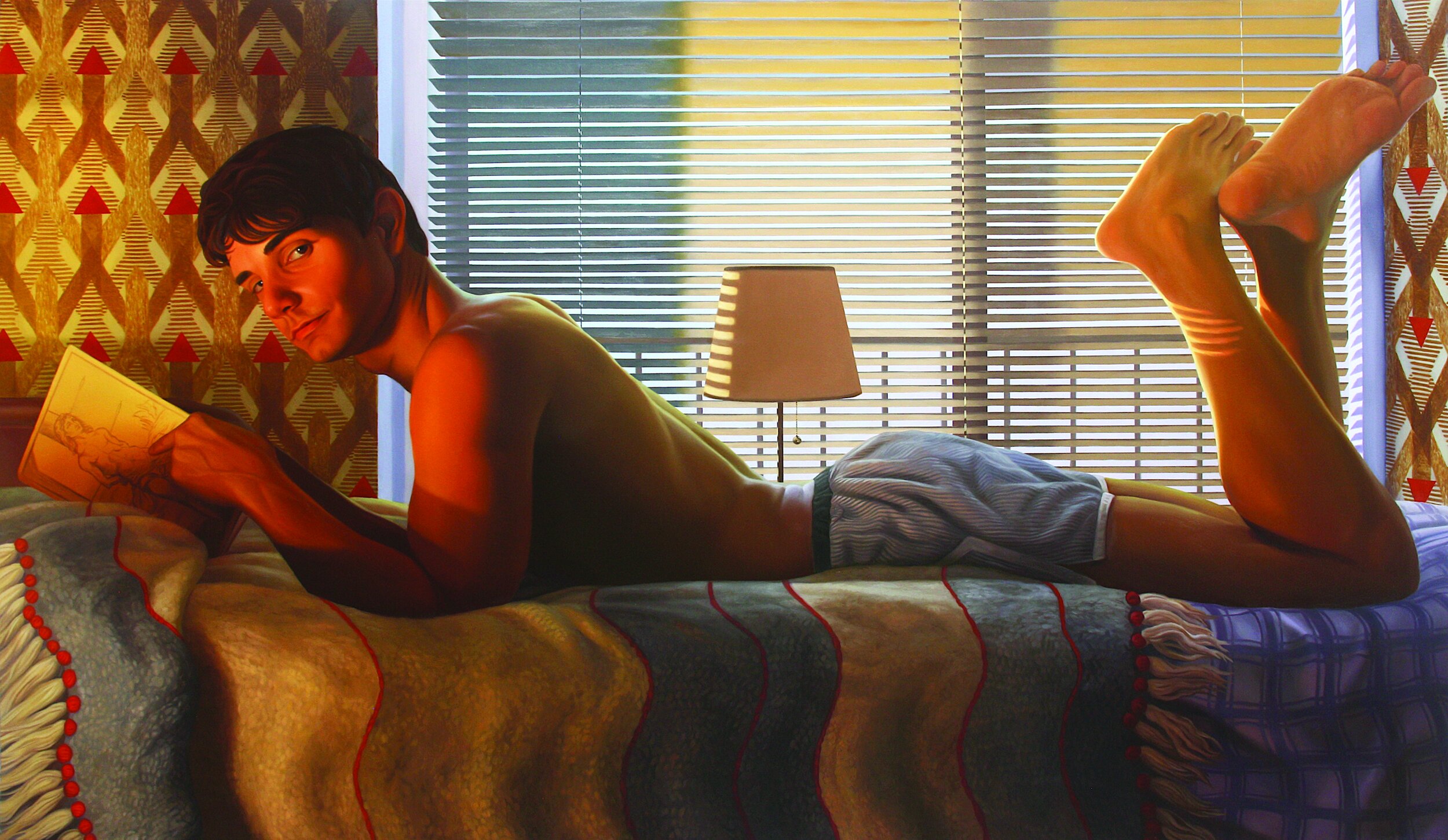The Art of the Lie: Laura Krifka's intimate acts of deception
By Madeleine Eve Ignon
To look at Laura Krifka’s paintings is to feel privy to – or rather, implicated in – intimate, disquieting and deeply intriguing snapshots of charged human interaction. Desire and fetish are laid bare, in some instances quite literally.
Krifka’s carefully constructed scenes play out themes of sex, power and desire, and the churning undercurrents of taboo that correspond to those themes. The paintings capture the real and the unreal, the fleeting and the fixed, the interior and the exterior. They cleverly draw on and reinvent canonical tropes and techniques, allowing Krifka to explore modern psychologies and dynamics.
Her figures, seldom fully clothed and often contorted against intricate patterns, seem to anticipate the viewer’s inevitably voyeuristic gaze. It’s as if you just happened to catch them in a private moment, and in an instant of sudden, unwelcome awareness, you are confronted with what it means to be The Gaze.
Laura Krifka, Tipping Point, 2019, oil on canvas, 36 x 60 in.
There is always more to see in Krifka’s paintings, through her clever use of mirrors and windows to expose new angles, uncover another intimate scene, a moment of exhibitionism. Krifka’s paintings pose many subtle questions about the relationship of the figures within the works to each other and to their surroundings, and, most crucially, their relationship to the viewer.
Krifka’s works are about “the art of the lie.” She skillfully creates worlds and myths that paw at and entice the viewer. One is coaxed to see beyond the lushly painted skin and colorful patterns to the dark and deceptive clues hidden within.
Laura Krifka, Unreachable Spring, 2020, oil on canvas, 36 x 24 in. All images courtesy of the artist and Luis De Jesus Los Angeles.
Krifka is subtly engaging with the act of seduction, crafting a multi-layered mise en scène in each work. Like a filmmaker, she controls every aspect of the scenes she constructs, from building small-scale dioramas to capture lighting and composition, to posing, dressing and photographing her subjects – including herself.
Many of her works feel like they could be a stolen frame of a warmly-lit, long-lost, Surrealist soft-core California porn-noir. And they are reminiscent of the inherent dichotomies of pornography.
“No one gets implicated if they don’t get seduced,” Krifka says. “You have to get pulled in for you to also be implicated.”
And as she pulls us in, we are compelled to ask: Who are we when we gaze? What happens to us in the space between attempting to maintain a safe distance and fully engaging with a provocative image – when the very act of looking is a kind of participation, and demands culpability?
One might say all paintings need a viewer to be complete. What becomes of art history’s infamous female nudes without the countless gazes that devour them?
As a female painter directly confronting this question in the twenty-first century, Krifka questions and subverts art historical tropes and the venerable tradition of the nude as subject, as well as the history of men painting women (or girls) with questionable motives. In her painting Copy Cat (2017), for example, she creates a subtle reference to Polish-French artist Balthus’ highly provocative and controversial 1938 work Thérèse Dreaming, which depicts a girl of about twelve with her legs on a chair, bent to reveal the slightest stain of menstruation blood.
Laura Krifka, Piggyback, 2019, oil on canvas, 60 x 72 in.
In Krifka’s piece, a woman in her early twenties is posed similarly, exposing pubic hair instead of the early mark of womanhood.
“It is an inherently cruel act to be a figurative painter,” Krifka says. She contorts and controls her subjects, butchering the body and creating amalgamations of things that can’t exist on the human body. That act, she says, is “powerful but mocking.” However, Krifka does this with visible care and attention and, as she describes, her figures exist in a world where that potential cruelty, that control, is readily acknowledged. Krifka’s paintings also steer away from gore or the overtly grotesque or pornographic.
Laura Krifka, Lions, 2019, oil on panel, 60 x 40 in.
Much of Krifka’s new work, which debuts at Luis de Jesus Gallery in the spring of 2022, shies away from faces and the erotically charged confrontations exhibited in her previous solo show. After a long period of isolation during the pandemic, Krifka describes a feeling of absence from people, of abject unknowability. She became acquainted with that all-too-familiar feeling of gradually losing touch with the people around her. Other peoples’ motives, desires and beliefs seem farther removed than ever.
Her previous paintings describe a particular kind of interior containment, but what happens when that containment is forced? How has our collective relationship to each other, and to our own gaze, changed since March 2020, when we were cut off from regular, casual access? How does this new period of liminality change our interior and exterior spaces, both physical and social? Laura Krifka is an artist committed to the exploration of these questions in her curious, generous and generative works.
Cover Image: Laura Krifka, Between Us, 2019, oil on canvas, 36 x 42 in.









